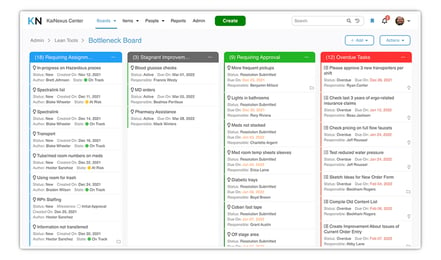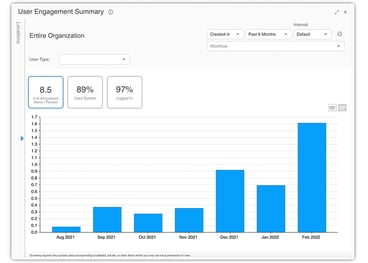When leading a Lean transformation, a consultant’s most important job is to help plant and grow a culture of continuous improvement in an organization.
Planting a seed takes careful nurturing and dedication to actually grow the plant. Once a plant starts growing, it can't be abandoned. A plant gives warning signs if it is in trouble. If a plant starts to brown, it might need more sunlight. If the plant starts to wilt, it might need more water.
Speaking with many consultants, I find that one of their biggest worries is that when they finish an engagement, they will come back a few months later to find that plant that they worked so hard to grow is wilted and dying.
An improvement culture cannot be created with a “drop and grow” approach; it needs careful maintenance to grow strong. However, it isn’t easy to measure the health of an improvement culture with spreadsheets or SharePoint files. While a plant gives warning signs in multiple ways, a spreadsheet does not. The only way to know if a culture is failing is that the spreadsheet won’t get filled out.
Listen to this Post or Subscribe to the Podcast:
For consultants, bringing a continuous improvement software platform into their repertoire gives them the ability to conduct health checks on their clients without even being in the building. Software keeps track of due dates, engagement, and participation rates, giving consultants and improvement leaders added tools to keep growing their culture.
Specific boards and reporting capabilities partnered with powerful filtering features within continuous improvement software give the ability to see not just an entire organization, but to dive down into specific department or location levels.
Three types of metrics will give you and your client insight into the health of improvement culture: activity metrics, engagement metrics, and impact metrics.
Activity Metrics
Understanding what type of improvement is happening and how often is the first step in assessing your client's improvement culture's health. This information will demonstrate how hard the organization is working toward positive change, who is actively involved in the effort, and whether more training or coaching is needed.
 Bottleneck Board
Bottleneck Board
A Bottleneck Board is a board that allows Lean consultants and improvement leaders to monitor improvement ideas that hit snags or bottlenecks.
These bottlenecks could be that ideas are not being assigned in a timely manner, ideas that are severely overdue, or ideas that have been submitted to be reviewed by managers.
The idea behind a bottleneck board is that it gives oversight into areas that have become sticking points for ideas and allows consultants and improvement leaders to more effectively coach their organizations.
User and Location Activity Boards
The User and Location Boards are great tools that show who is doing improvement work and who isn’t. The lists can show which staff members submitted ideas and how many, how many are working on improvements, how many are complete, and even separate the improvements that led to a change.
These boards can showcase this by individual staff members or widen the scope to see departments or locations. Similar to how the Bottleneck Board can show improvement leaders where to coach based on where ideas get stuck, the Activity Boards show leaders where to coach based on who is doing work and who is not.
Improvement Curve
In the best case, improvements are completed at about the same rate as new opportunities are submitted. Projects that lose steam after being selected for implementation bring down morale, decrease engagement, and create a negative impact. You and your client should be able to check the percentage of in-progress improvements at any time and find ways to get more effective by increasing that number.
Status Reports
Visibility into the current state of all improvements helps you and the team assess how well work progresses from stage to stage. In a healthy improvement culture, there are few overdue improvements because people prioritize getting this work done to enjoy the positive impact. Therefore, the healthier the culture, the more significant the ROI.
Engagement Metrics
By tracking which team members are actively working on improvement projects over time, you and your client can find averages, compare current results to the norms, and discover any trends. For example, you'll know whether the ROI your client has achieved is due to a small group of people, a sign of a weak culture, or a large group indicating a health culture.
User and Location Engagement Summary

The User Engagement Summary is a simple way to show who is submitting improvements and who is participating in the discussion. The report calculates Annualized Improvements per Person, which is a great way to stack departments against each other to see who can get the most out of each person. It also provides data on who is participating in improvement work, which is another way that continuous improvement software helps direct coaching.
The same can be said about the Location Engagement Summary, except you can use it to track the engagement levels of locations within an organization, giving improvement leaders and consultants the data they need to increase engagement levels wherever they are lacking.
User Participation Rates
A small number of users making a significant impact is often an unsustainable anomaly. The ideal participation rate report will show engagement that is spread over many people and departments.
Impact Metrics
The impact of improvement on the key performance indicators is essential to measure. In addition to economic metrics, it's also necessary to track qualitative variables such as lead time, safety, customer satisfaction, and environmental impact.
Impact Summary
Continuous improvement software allows you and your client to connect improvement with impact in reporting so that you can drill down into any number to verify accuracy. So if a cost reduction looks impossibly high, for example, you can quickly see what improvements are contributing to it and validate that the reporting impact on each is correct.
Helping your client measure the right things is the best antidote for a wilted improvement culture. With your help, they can keep their eye on the ball and celebrate positive trends. Measuring the right things will boost their improvement efforts. It will make it easier to justify continued investment in your work and the supporting technology. Perhaps more importantly, it will prove to you and your client that improvement can be controlled and managed.
Have any questions about how continuous improvement software can help grow your improvement culture? Comment below and I’ll be happy to help you out!



Add a Comment